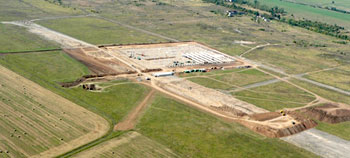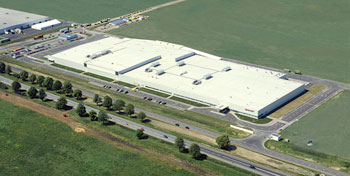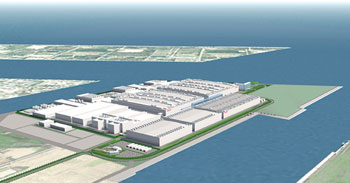

astern Europe is reaping the benefit of a major global upswing in the demand for flat-panel televisions. The Czech Republic and Poland are among countries seeing major foreign investment in the sector. Industry observers expect Europe’s love for flat-screen TVs to grow to 30 percent of world demand by 2011. While most of the world’s LCD panel manufacturing resides in Asia, LCD module assembly and LCD television assembly have begun migrating to the low-wage countries of Eastern Europe.
Sweta Dash, director of LCD research for El Segundo, Calif.-based iSuppli, a market intelligence firm serving the electronics industry, says the migration is a case of manufacturers moving closer to the market for LCD assembly operations.
“Europe is one of the world’s biggest markets for LCD TVs and is expected to continue growing at a very fast rate,” Dash says.
Several factors are driving sales of LCD TVs in Europe, Dash believes. These include the following:
• The smaller structure of European homes is conducive to the smaller footprint of LCD TVs;
• The cost of LCD TVs is dropping;
• The shift is on from analog television to digital;
• Manufacturers are introducing more products;
• Flat-panel TVs are considered to be superior.
“Some manufacturers are receiving big government support because they are bringing in jobs,” Dash says. “The economic situation in some Eastern European countries is improving, driving the growth of LCD TVs. Plus more and more suppliers want to set up assembly there. We see this trend continuing and even getting stronger going forward. More TVs will be sold in Europe and more of them will be assembled in Europe.”
Japanese flat-screen television manufacturer IPS Alpha Technology produced its first Czech-made LCD monitor in July at its new US$56-million facility in The Triangle industrial zone in Zatec, in the country’s Usti region, an area that has suffered from high unemployment. The plant, which will eventually employ about 2,000, has capacity to manufacture approximately five million 32-inch LCD panels annually, but will probably reach the two million mark by the end of 2007. Housing specifications in Europe are spurring demand for TVs in the 30-inch range.
IPS Alpha Technology is a joint venture established by Hitachi Displays, Matsushita Electric Industrial, Toshiba Corp. and others. The companies selected the Czech Republic site to expand sales in the European market where demand for LCD TVs is high. Officials of the joint venture firms say LCD TV demand is being spurred by global events such as the upcoming 2008 Beijing Summer Olympic Games. They predict that sales of flat-panel TVs will account for more than 60 percent of the worldwide TV market by 2010.
Triangle, comprising 900 acres (364 hectares), is one of the Czech Republic’s three strategic industrial zones. It’s also one of the country’s largest brownfield regeneration projects, located on the site of a former military airfield. The conversion of the base began in 2002.
Hitachi is also opening a separate LCD facility in The Triangle.

The electronics specialist is investing $131 million in a plant that will also eventually employ 2,000.
Japanese manufacturer Sharp opened its new $61-million, 439,000-sq.-ft. (40,778-sq.-m.) plant in Torun, Poland, in August. The factory, Sharp’s first LCD operation in Europe, employs approximately 1,300. Sharp plans to produce 10 million LCD modules annually at the plant by 2011.
Korean manufacturer LG has a much larger investment in Poland with development of an LCD cluster in Wroclaw, the company’s third such cluster worldwide. The company’s other clusters are located in Paju, Korea, and Nanjing, China.
The company held opening ceremonies for the cluster in May, and expects to invest a total of $1.1 billion in the complex by 2011. The cluster includes operations from four company divisions: LG Philips LCD, LG Electronics, LG Innotex and LG Chem. LG is developing a “one-stop” manufacturing system, allowing LCD products and components to be manufactured and assembled at a single location.
“As the demand for LCD TVs is increasing more rapidly in Europe than any other region, the Poland cluster will play a core part in LG’s overall LCD-related businesses,” said Yong Nam, vice chairman and CEO of LG Electronics.
LG said it chose Poland for its advantageous geographic location, competitive work force, established infrastructure and high level of support from the national government.
Sharp has even larger plans for a “Manufacturing Complex for the 21st Century” in its home country. It will build on the same site an LCD panel plant and a solar cell plant for mass production of thin-film solar cells.

The plants will be built in Sakai City, Osaka Prefecture.
Sharp’s planned LCD panel plant will be the first in the world to use 10th-generation glass substrates, the world’s largest. Construction on the $3.3-billion plant is set to begin in November with production scheduled to start by March 2010.
Sharp is the world’s largest manufacturer of solar cells. The solar cell plant will focus on mass production of thin-film solar cells that achieve a power generating efficiency that is among the best in the industry. The construction timetable is the same as the LCD plant.
Taiwan’s AU Optronics Corp., one of the world’s top LCD makers, has opened a manufacturing facility in Xiamen, China, its second in that country. The 2.7-million-sq.-ft. (250,000-sq.-m.) facility will manufacture small-, medium- and large-sized LCD modules. Small and medium modules are used for devices such as wireless phones and personal media players.
“Xiamen is one of the most economically dynamic cities in Fujian Province, and offers great potential,” said Fred Hsieh, general manager of AU Optronics (Xiamen) Corp.
Site Selection Online – The magazine of Corporate Real Estate Strategy and Area Economic Development.
©2007 Conway Data, Inc. All rights reserved. SiteNet data is from many sources and not warranted to be accurate or current.